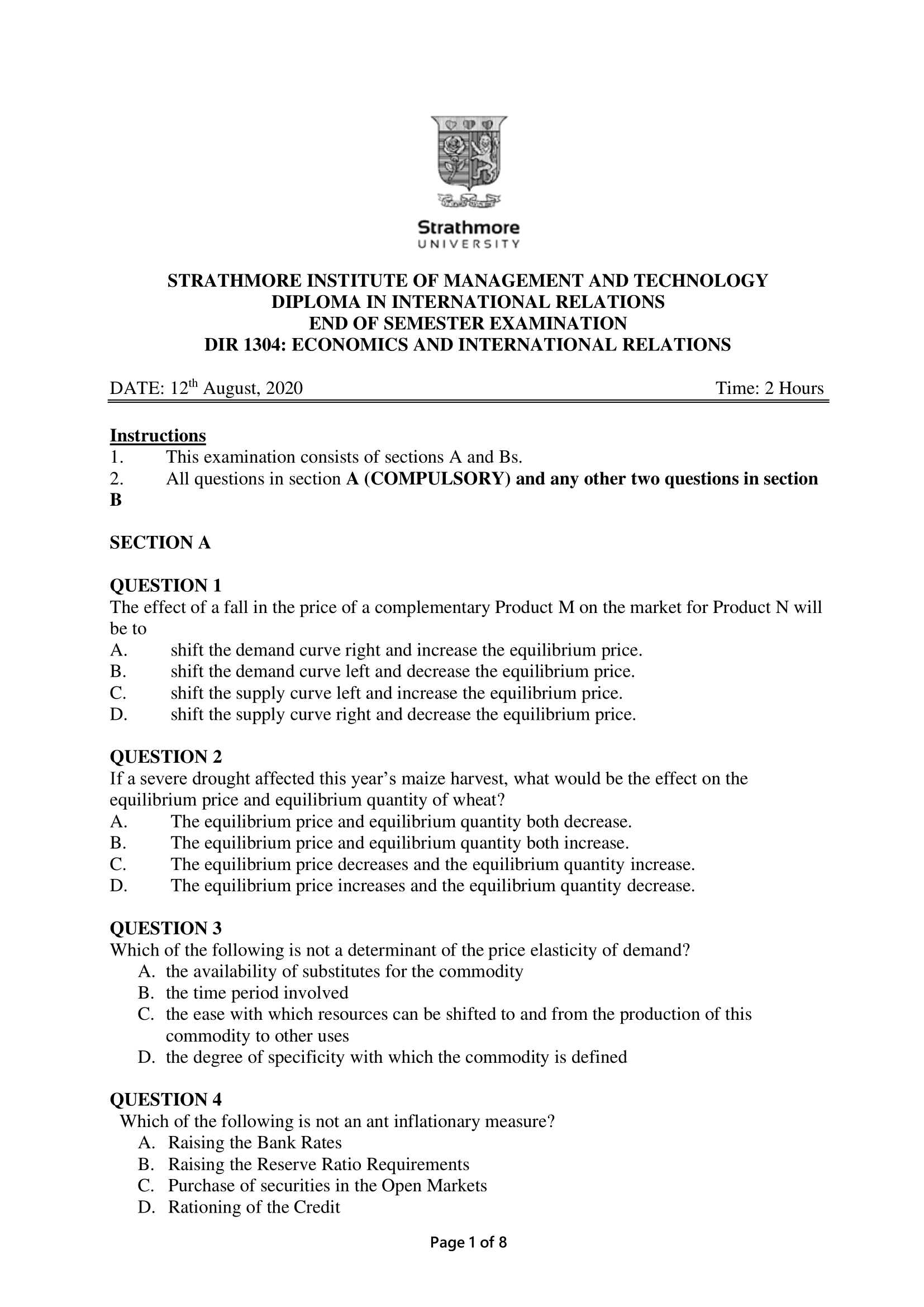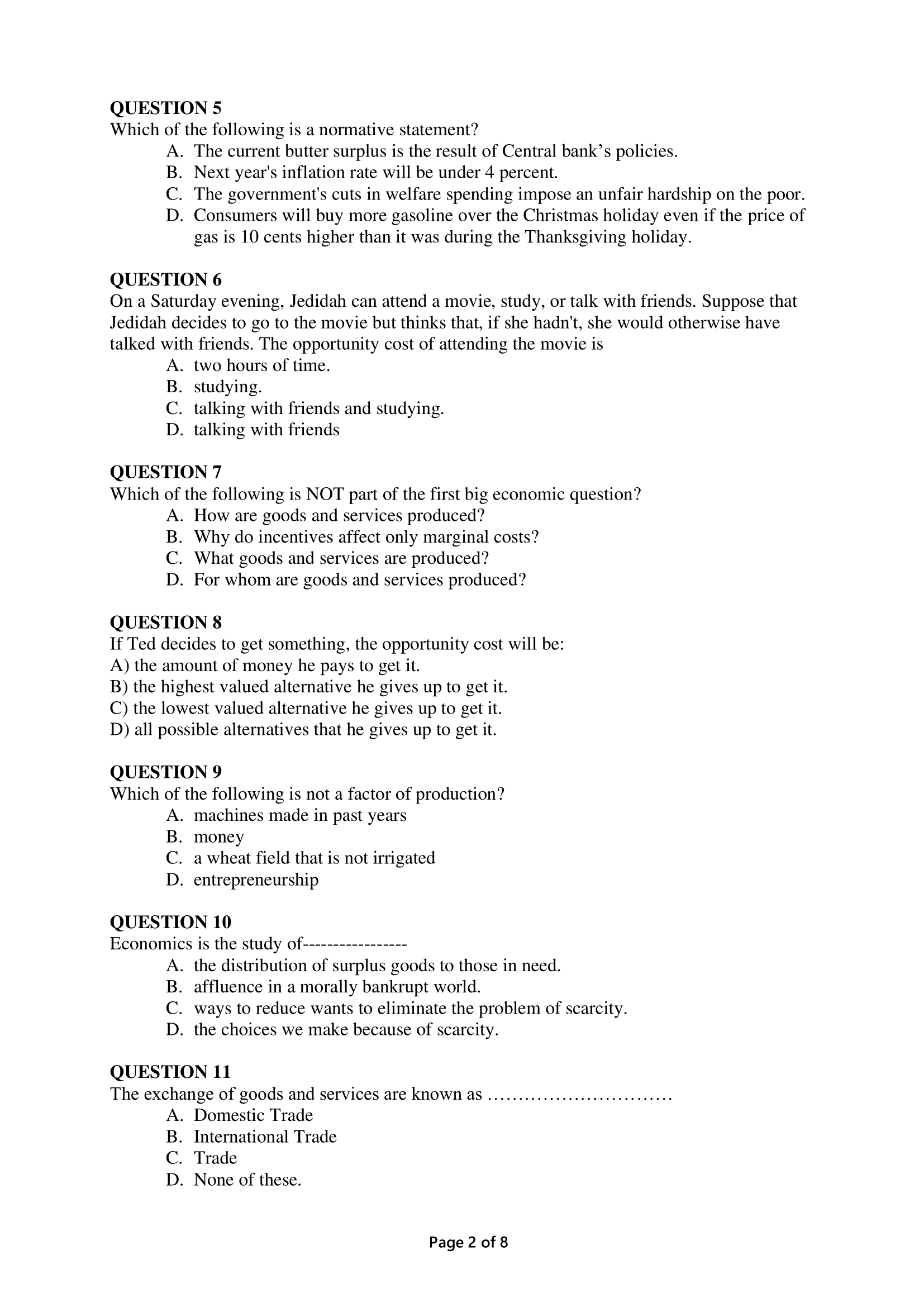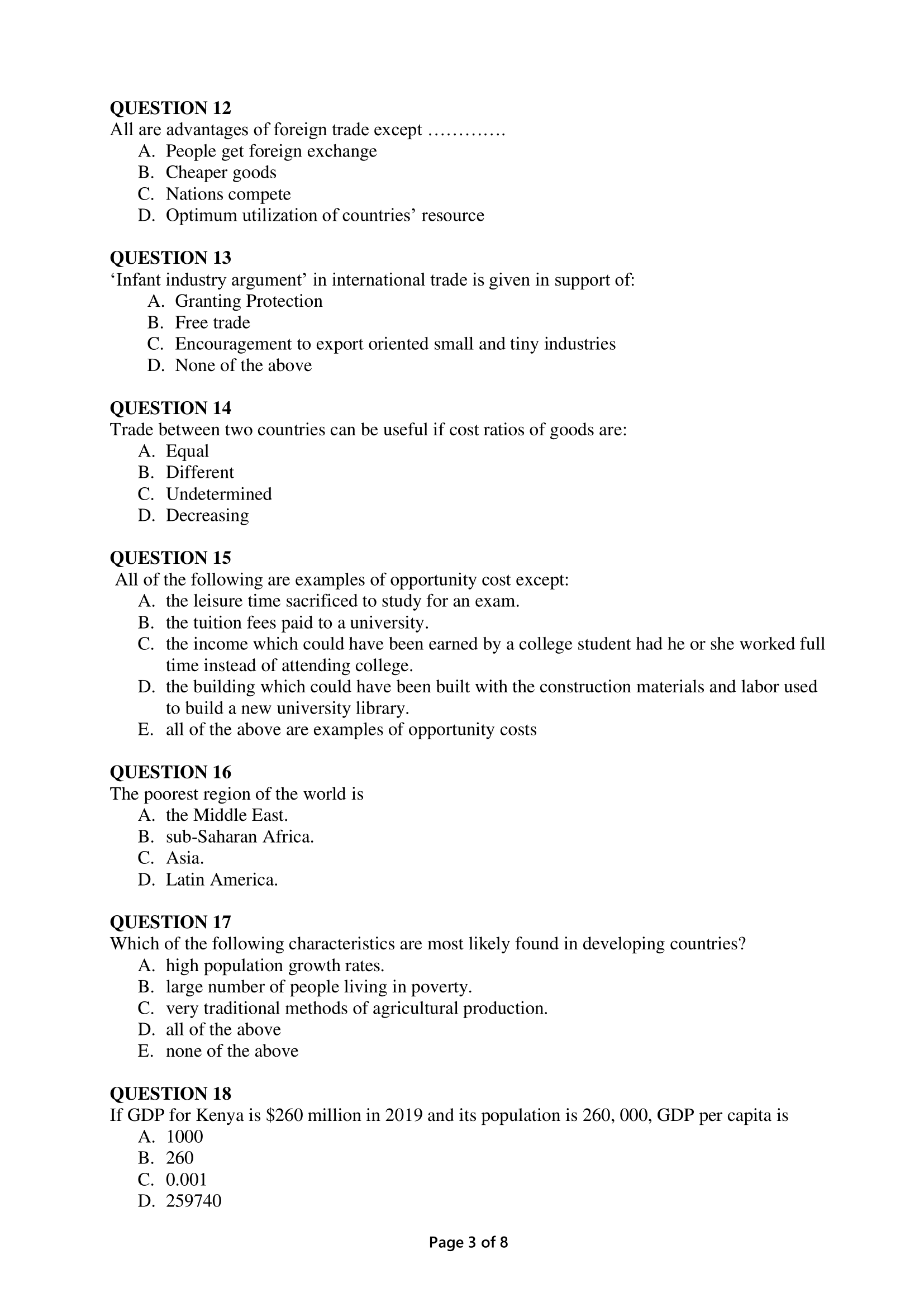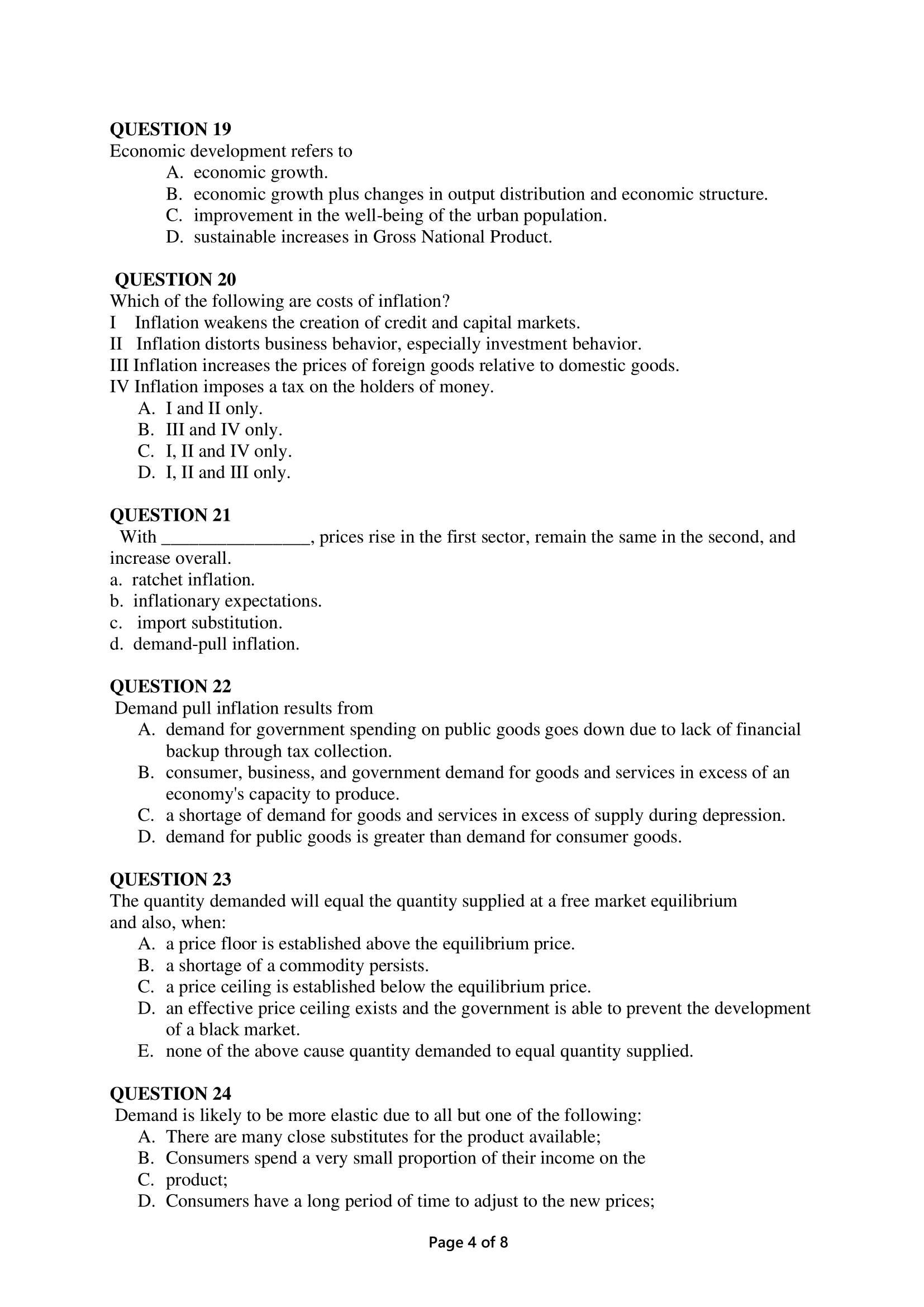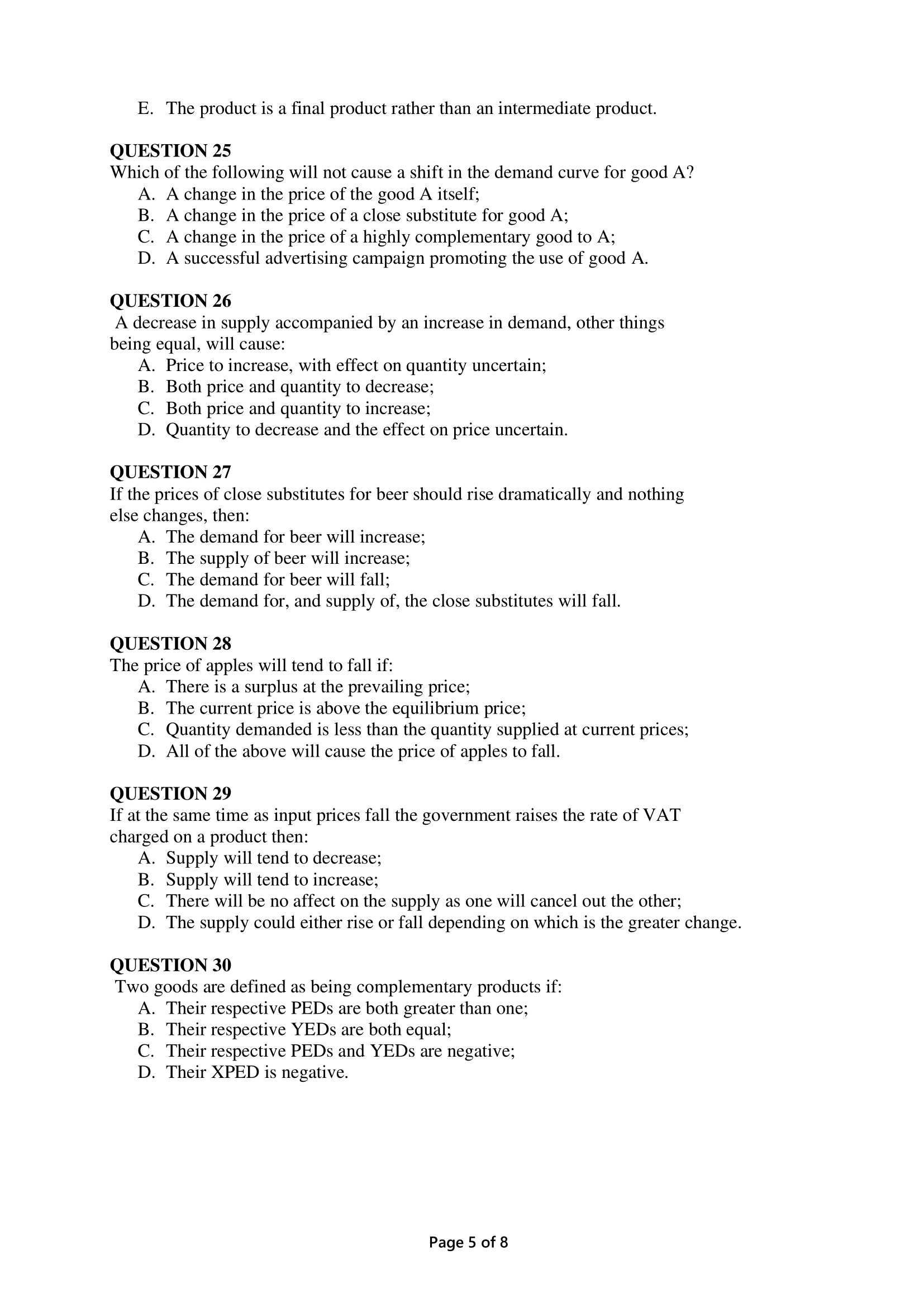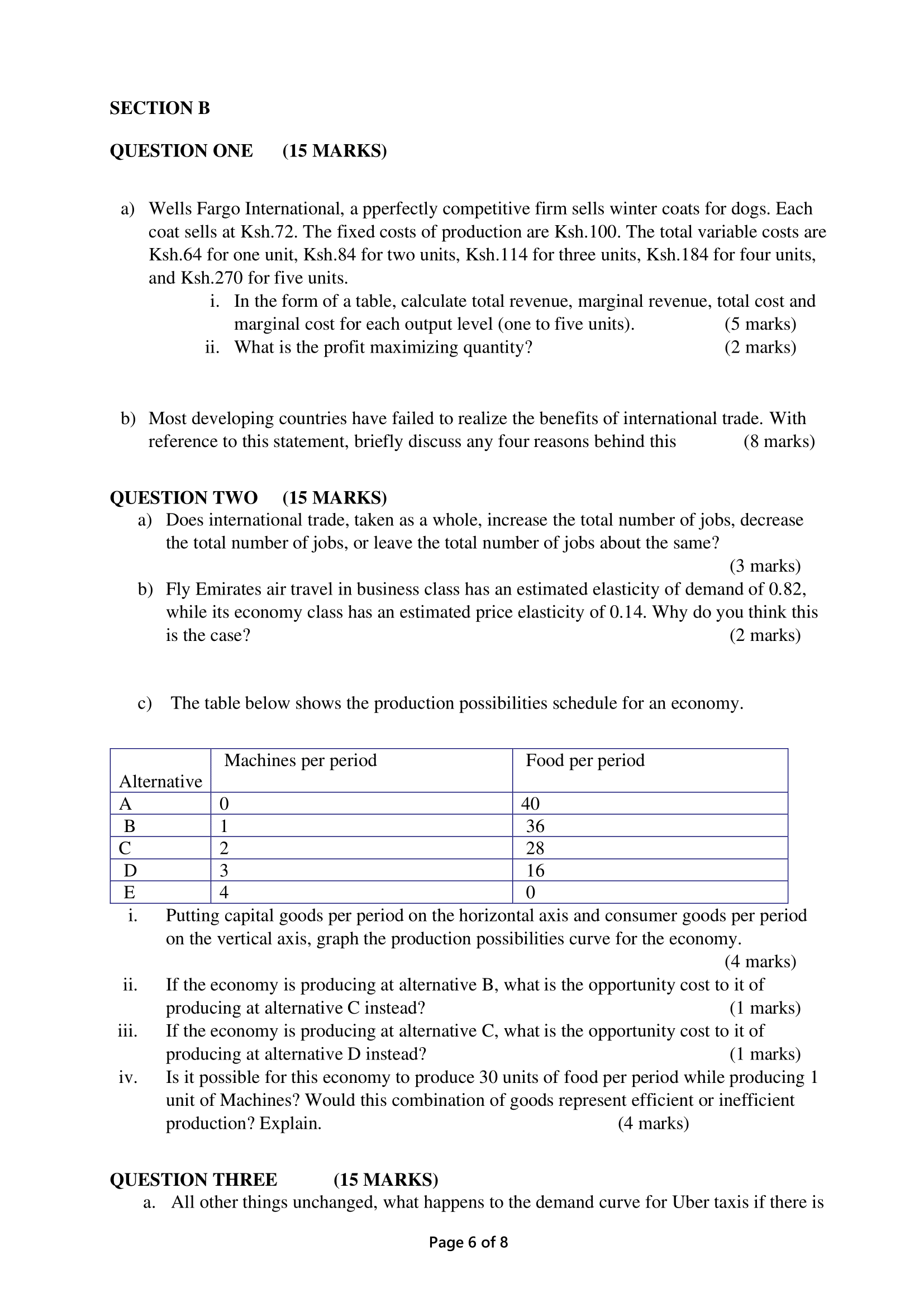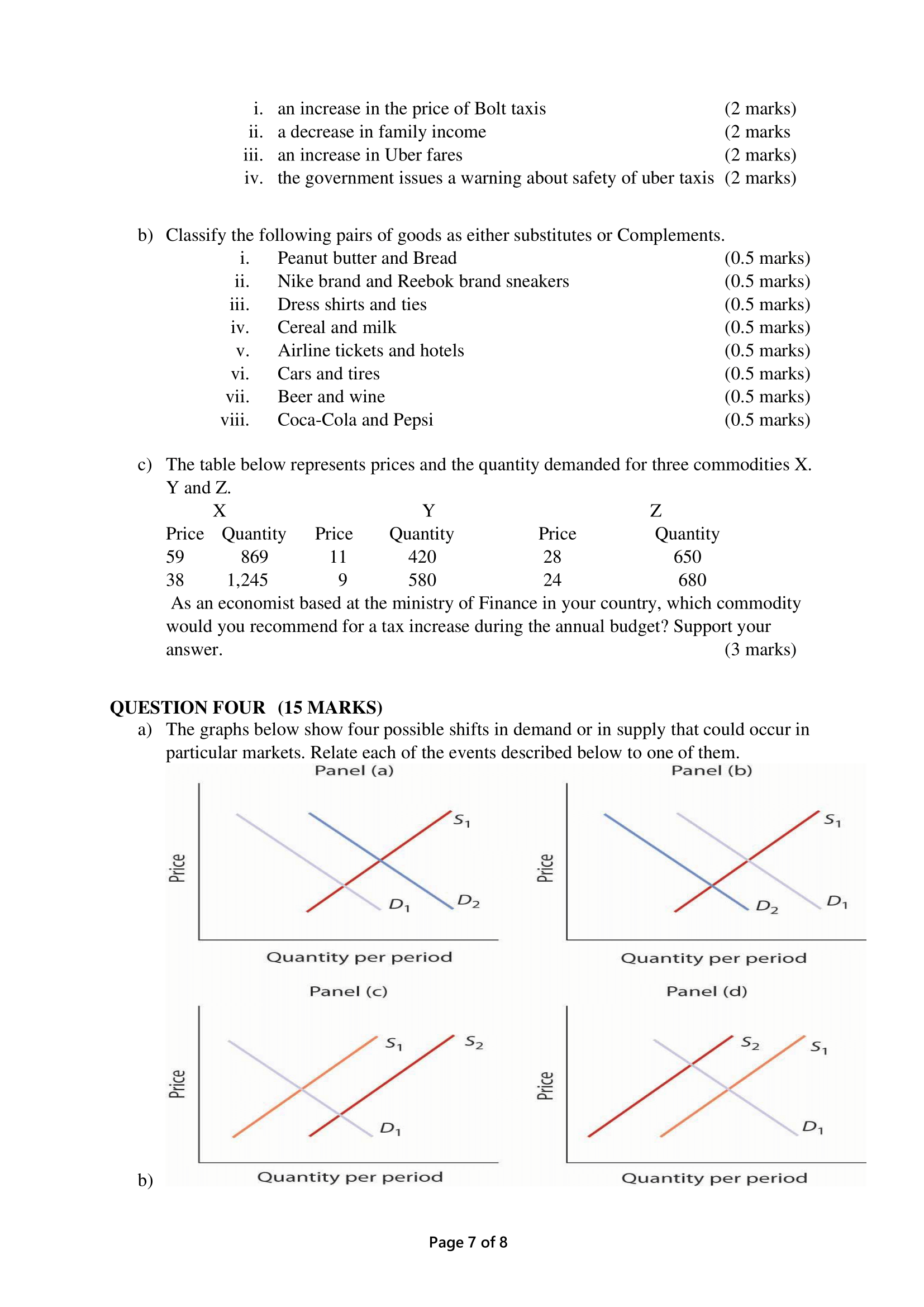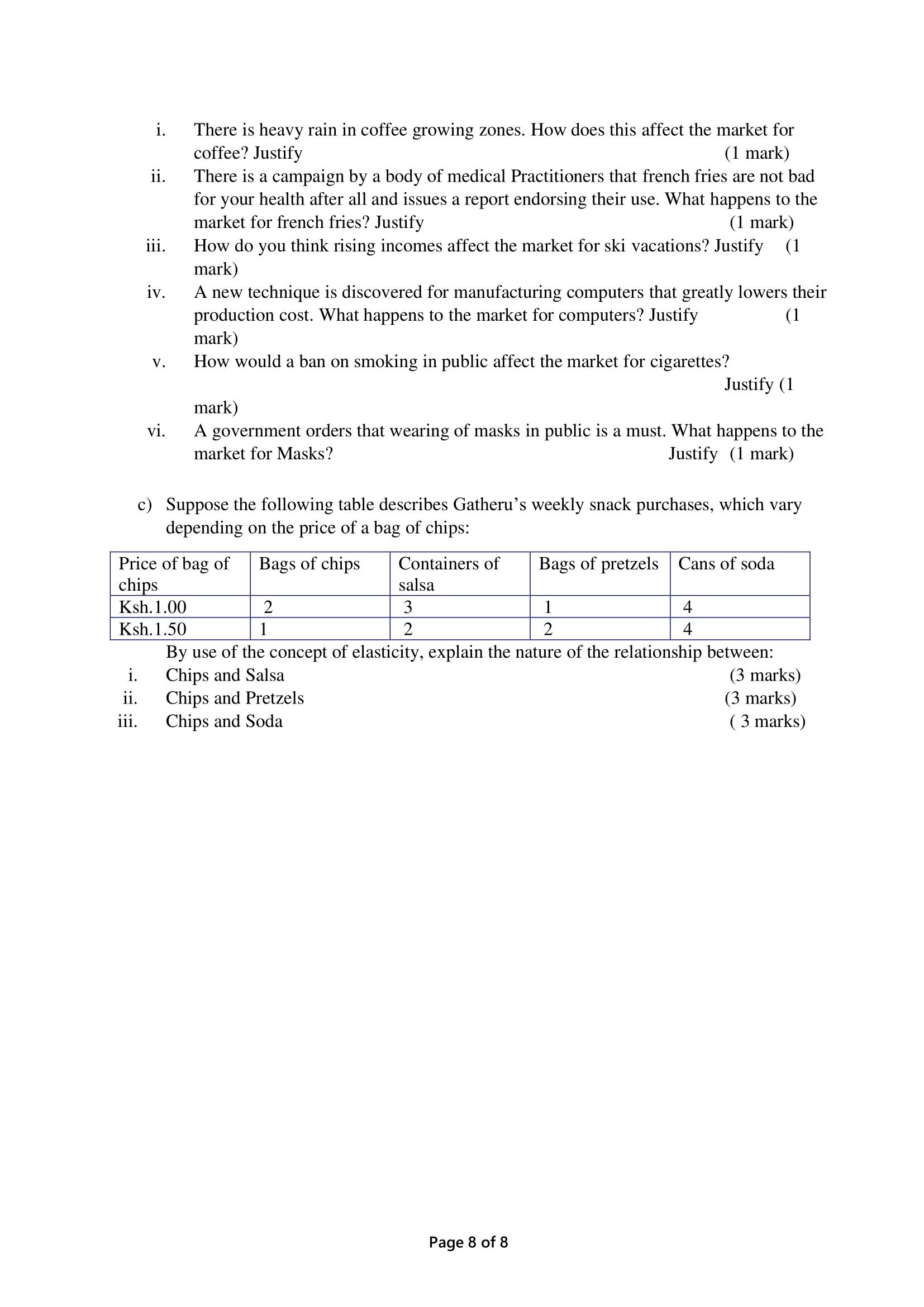Stralhmore U N I V E R SITY STRATHMORE INSTITUTE OF MANAGEMENT AND TECHNOLOGY DIPLOMA IN INTERNATIONAL RELATIONS END OF SEMESTER EXAMINATION DIR 1304: ECONOMICS AND INTERNATIONAL RELATIONS DATE: 12'h August, 2020 Time: 2 Hours Instructions 1. This examination consists of sections A and Bs. 2. All questions in section A (COMPULSORY) and any other two questions in section B SECTION A QUESTION 1 The effect of a fall in the price of a complementary Product M on the market for Product N will be to A. shift the demand curve right and increase the equilibrium price. B. shift the demand curve left and decrease the equilibrium price. C. shift the supply curve left and increase the equilibrium price. D. shift the supply curve right and decrease the equilibrium price. QUESTION 2 If a severe drought affected this year's maize harvest, what would be the effect on the equilibrium price and equilibrium quantity of wheat? A. The equilibrium price and equilibrium quantity both decrease. B. The equilibrium price and equilibrium quantity both increase. C. The equilibrium price decreases and the equilibrium quantity increase. D. The equilibrium price increases and the equilibrium quantity decrease. QUESTION 3 Which of the following is not a determinant of the price elasticity of demand? A. the availability of substitutes for the commodity B. the time period involved C. the ease with which resources can be shifted to and from the production of this commodity to other uses D. the degree of specificity with which the commodity is defined QUESTION 4 Which of the following is not an ant inationary measure? A. Raising the Bank Rates B. Raising the Reserve Ratio Requirements C. Purchase of securities in the Open Markets D. Rationing of the Credit Page1 of 8 QUESTION 5 Which of the following is a normative statement? . The current butter surplus is the result of Central bank's policies. Next year's ination rate will be under 4 percent. The government's cuts in welfare spending impose an unfair hardship on the poor. . Consumers will buy more gasoline over the Christmas holiday even if the price of gas is 10 cents higher than it was during the Thanksgiving holiday. oow> QUESTION 6 On a Saturday evening, Jedidah can attend a movie, study, or talk with friends. Suppose that Jedidah decides to go to the movie but thinks that, if she hadn't, she would otherwise have talked with friends. The opportunity cost of attending the movie is A. two hours of time. B. studying. C. talking with friends and studying. D. talking with friends QUESTION 7 Which of the following is NOT part of the first big economic question? A. How are goods and services produced? B. Why do incentives affect only marginal costs? C. What goods and services are produced? D. For whom are goods and services produced? QUESTION 8 If Ted decides to get something, the opportunity cost will be: A) the amOunt of money he pays to get it. B) the highest valued alternative he gives up to get it. C) the lowest valued alternative he gives up to get it. D) all possible alternatives that he gives up to get it. QUESTION 9 Which of the following is not a factor of production? A. machines made in past years B. money C. a wheat field that is not irrigated D. entrepreneurship QUESTION 10 Economics is the study of ----------------- A. the distribution of surplus goods to those in need. B. afuence in a morally bankrupt world. C. ways to reduce wants to eliminate the problem of scarcity. D. the choices we make because of scarcity. QUESTION 11 The exchange of goods and services are known as .............................. A. Domestic Trade B. International Trade C. Trade D. None of these. Page 2 of 8 QUESTION 12 All are advantages of foreign trade except ............. A. People get foreign exchange B. Cheaper goods C. Nations compete D. Optimum utilization of countries' resource QUESTION 13 'Infant industry argument' in international trade is given in support of: A. Granting Protection B. Free trade C. Encouragement to export oriented small and tiny industries D. None of the above QUESTION 14 Trade between two countries can be useful if cost ratios of goods are: A. Equal B. Different C. Undetermined D. Decreasing QUESTION 15 All of the following are examples of opportunity cost except: A. the leisure time sacriced to study for an exam. B. the tuition fees paid to a university. C. the income which could have been earned by a college student had he or she worked full time instead of attending college. D. the building which could have been built with the construction materials and labor used to build a new university library. E. all of the above are examples of opportunity costs QUESTION 16 The poorest region of the world is A. the Middle East. B. subSaharan Africa. C. Asia. D. Latin America. QUESTION 17 Which of the following characteristics are most likely found in developing countries? A. high population growth rates. B, large number of people living in poverty. C. very traditional methods of agricultural production. D. all of the above E. none of the above QUESTION 18 If GDP for Kenya is $260 million in 2019 and its population is 260, 000, GDP per capita is A. 1000 B. 260 C. 0.001 D. 259740 Page 3 of 8 QUESTION 19 Economic development refers to A. economic growth. B. economic growth plus changes in output distribution and economic structure. C. improvement in the well-being of the urban population. D. sustainable increases in Gross National Product. QUESTION 20 Which of the following are costs of inflation? I Inflation weakens the creation of credit and capital markets. II Inflation distorts business behavior, especially investment behavior. III Inflation increases the prices of foreign goods relative to domestic goods. IV Inflation imposes a tax on the holders of money. A. I and II only. B. III and IV only. C. I, II and IV only. D. I, II and III only. QUESTION 21 With prices rise in the first sector, remain the same in the second, and increase overall. a. ratchet inflation. b. inflationary expectations. c. import substitution. d. demand-pull inflation. QUESTION 22 Demand pull inflation results from A. demand for government spending on public goods goes down due to lack of financial backup through tax collection. B. consumer, business, and government demand for goods and services in excess of an economy's capacity to produce. C. a shortage of demand for goods and services in excess of supply during depression. D. demand for public goods is greater than demand for consumer goods. QUESTION 23 The quantity demanded will equal the quantity supplied at a free market equilibrium and also, when: A. a price floor is established above the equilibrium price. B. a shortage of a commodity persists. C. a price ceiling is established below the equilibrium price. D. an effective price ceiling exists and the government is able to prevent the development of a black market. E. none of the above cause quantity demanded to equal quantity supplied. QUESTION 24 Demand is likely to be more elastic due to all but one of the following: A. There are many close substitutes for the product available; B. Consumers spend a very small proportion of their income on the C. product; D. Consumers have a long period of time to adjust to the new prices; Page 4 of 8E. The product is a nal product rather than an intermediate product. QUESTION 25 Which of the following will not cause a shift in the demand curve for good A? A. A change in the price of the good A itself; B. A change in the price of a close substitute for good A; C. A change in the price of a highly complementary good to A; D. A successful advertising campaign promoting the use of good A. QUESTION 26 A decrease in supply accompanied by an increase in demand, other things being equal, will cause: A. Price to increase, with effect on quantity uncertain; B, Both price and quantity to decrease; C. Both price and quantity to increase; D. Quantity to decrease and the effect on price uncertain. QUESTION 27 If the prices of close substitutes for beer should rise dramatically and nothing else changes, then: A. The demand for beer will increase; B. The supply of beer will increase; C. The demand for beer will fall; D. The demand for, and supply of, the close substitutes will fall. QUESTION 28 The price of apples will tend to fall if: A. There is a surplus at the prevailing price; B. The current price is above the equilibrium price; C. Quantity demanded is less than the quantity supplied at current prices; D. All of the above will cause the price of apples to fall. QUESTION 29 If at the same time as input prices fall the govermnent raises the rate of VAT charged on a product then: A. Supply will tend to decrease; B. Supply will tend to increase; C. There will be no affect on the supply as one will cancel out the other; D. The supply could either rise or fall depending on which is the greater change. QUESTION 30 Two goods are defined as being complementary products if: A. Their respective PEDs are both greater than one; B. Their respective YEDs are both equal; C. Their respective PEDs and YEDs are negative; D. Their XPED is negative. Page 5 of 8 SECTION B QUESTION ONE (15 MARKS) a) Wells Fargo International, a pperfectly competitive firm sells winter coats for dogs. Each coat sells at Ksh.72. The xed costs of production are Ksh. 100. The total variable costs are Ksh.64 for one unit, Ksh.84 for two units, Ksh.114 for three units, Ksh. 184 for four units, and Ksh.270 for five units. i. In the form of a table, calculate total revenue, marginal revenue, total cost and marginal cost for each output level (one to five units). (5 marks) ii. What is the profit maximizing quantity? (2 marks) b) Most developing countries have failed to realize the benefits of international trade. With reference to this statement, briey discuss any four reasons behind this (8 marks) QUESTION TWO (15 MARKS) a) Does international trade, taken as a whole, increase the total number of jobs, decrease the total number of jobs, or leave the total number of jobs about the same? (3 marks) b) Fly Emirates air travel in business class has an estimated elasticity of demand of 0.82, while its economy class has an estimated price elasticity of 0.14. Why do you think this is the case? (2 marks) 0) The table below shows the production possibilities schedule for an economy. Machines per period Food per period Alternative Putting capital goods per period on the horizontal axis and consumer goods per period on the vertical axis, graph the production possibilities curve for the economy. (4 marks) ii. If the economy is producing at alternative B, what is the opportunity cost to it of producing at alternative C instead? (1 marks) iii. If the economy is producing at alternative C, what is the opportunity cost to it of producing at alternative D instead? (1 marks) iv. Is it possible for this economy to produce 30 units of food per period while producing 1 unit of Machines? Would this combination of goods represent efficient or inefficient production? Explain. (4 marks) QUESTION THREE (15 MARKS) a. All other things unchanged, what happens to the demand curve for Uber taxis if there is Page 6 of 8 i. an increase in the price of Bolt taxis (2 marks) ii. a decrease in family income (2 marks iii. an increase in Uber fares (2 marks) iv. the government issues a warning about safety of uber taxis (2 marks) b) Classify the following pairs of goods as either substitutes or Complements. i. Peanut butter and Bread (0.5 marks) ii. Nike brand and Reebok brand sneakers (0.5 marks) iii. Dress shirts and ties (0.5 marks) iv. Cereal and milk (0.5 marks) v. Airline tickets and hotels (0.5 marks) vi. Cars and tires (0.5 marks) vii. Beer and wine (0.5 marks) viii. CocaCola and Pepsi (0.5 marks) 0) The table below represents prices and the quantity demanded for three commodities X. Y and Z. X Y Z Price Quantity Price Quantity Price Quantity 59 869 1 1 420 28 650 38 1,245 9 580 24 680 As an economist based at the ministry of Finance in your country, which commodity would you recommend for a tax increase during the annual budget? Support your answer. (3 marks) QUESTION FOUR (15 MARKS) a) The graphs below show four possible shifts in demand or in supply that could occur in particular markets. Relate each of the events described below to one of them. Panel (a) Panel (b) a) cu .2 .2 E 5 Quantity per period Quantity per period Panel (c) Panel (d) g /:: 8 & //- E b) Quantity per period Quantity per period Page 7 of 8 i. There is heavy rain in coffee growing zones. How does this affect the market for coffee? Justify (1 mark) ii. There is a campaign by a body of medical Practitioners that french fries are not bad for your health after all and issues a report endorsing their use. What happens to the market for french fries? Justify (1 mark) iii. How do you think rising incomes affect the market for ski vacations? Justify (1 mark) iv. A new technique is discovered for manufacturing computers that greatly lowers their production cost. What happens to the market for computers? Justify (1 mark) v. How would a ban on smoking in public affect the market for cigarettes? Justify (1 mark) vi, A government orders that wearing of masks in public is a must. What happens to the market for Masks? Justify (1 mark) 0) Suppose the following table describes Gatheru's weekly snack purchases, which vary depending on the price of a bag of chips: Price of bag of Bags of chips Containers of Bags of pretzels Cans of soda chips salsa Ksh.1.00 3 Ksh.1.50 2 By use of the concept of elasticity, explain the nature of the relationship between: i. Chips and Salsa (3 marks) ii. Chips and Pretzels (3 marks) iii. Chips and Soda ( 3 marks) Page 8 of 8
